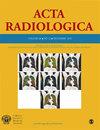使用不同翻转角演化(SPACE)迭代去噪的对比后加速三维 T1 取样完善与应用优化对比治疗颅内增强病变的临床可行性:一项回顾性研究。
IF 1.1
4区 医学
Q3 RADIOLOGY, NUCLEAR MEDICINE & MEDICAL IMAGING
引用次数: 0
摘要
背景使用不同翻转角演化(SPACE)的后对比 T1 取样完善与应用优化对比(Post-contrast T1-Sampling Perfection with Application-optimized Contrasts)是评估脑转移瘤的首选三维 T1 自旋回波序列,而无需考虑扫描时间的延长。材料和方法为了评估颅内病变,108 位患者在同一次成像过程中接受了标准和加速 T1-SPACE 扫描。结果虽然标准和加速 T1-SPACE 的整体图像质量和平均对比度-噪声鼠小血管/肾小管在无 ID 和有 ID 和无 ID 的加速 SPACE 之间有显著差异,但有 ID 的标准和加速 T1-SPACE 之间无显著差异。加速 T1-SPACE 显示的伪影多于标准 T1-SPACE;但是,带 ID 的加速 T1-SPACE 显示的伪影明显少于不带 ID 的加速 T1-SPACE。不带 ID 的加速 T1-SPACE 显示的增强病灶数量明显少于带 ID 的标准 T1-SPACE 和加速 T1-SPACE;但是,无论病灶大小如何,标准 T1-SPACE 和带 ID 的加速 T1-SPACE 之间没有明显差异。将 ID 应用于加速 T1-SPACE 可获得与标准 T1-SPACE 相当的整体图像质量,并能检测到脑实质中的增强病灶。带有 ID 的加速 T1-SPACE 有可能取代标准 T1-SPACE。本文章由计算机程序翻译,如有差异,请以英文原文为准。
Clinical feasibility of post-contrast accelerated 3D T1-Sampling Perfection with Application-optimized Contrasts using different flip angle Evolutions (SPACE) with iterative denoising for intracranial enhancing lesions: a retrospective study.
BACKGROUND
Post-contrast T1-Sampling Perfection with Application-optimized Contrasts using different flip angle Evolutions (SPACE) is the preferred 3D T1 spin-echo sequence for evaluating brain metastases, regardless of the prolonged scan time.
PURPOSE
To evaluate the application of accelerated post-contrast T1-SPACE with iterative denoising (ID) for intracranial enhancing lesions in oncologic patients.
MATERIAL AND METHODS
For evaluation of intracranial lesions, 108 patients underwent standard and accelerated T1-SPACE during the same imaging session. Two neuroradiologists evaluated the overall image quality, artifacts, degree of enhancement, mean contrast-to-noise ratiolesion/parenchyma, and number of enhancing lesions for standard and accelerated T1-SPACE without ID.
RESULTS
Although there was a significant difference in the overall image quality and mean contrast-to-noise ratiolesion/parenchyma between standard and accelerated T1-SPACE without ID and accelerated SPACE with and without ID, there was no significant difference between standard and accelerated T1-SPACE with ID. Accelerated T1-SPACE showed more artifacts than standard T1-SPACE; however, accelerated T1-SPACE with ID showed significantly fewer artifacts than accelerated T1-SPACE without ID. Accelerated T1-SPACE without ID showed a significantly lower number of enhancing lesions than standard- and accelerated T1-SPACE with ID; however, there was no significant difference between standard and accelerated T1-SPACE with ID, regardless of lesion size.
CONCLUSION
Although accelerated T1-SPACE markedly decreased the scan time, it showed lower overall image quality and lesion detectability than the standard T1-SPACE. Application of ID to accelerated T1-SPACE resulted in comparable overall image quality and detection of enhancing lesions in brain parenchyma as standard T1-SPACE. Accelerated T1-SPACE with ID may be a promising replacement for standard T1-SPACE.
求助全文
通过发布文献求助,成功后即可免费获取论文全文。
去求助
来源期刊

Acta radiologica
医学-核医学
CiteScore
2.70
自引率
0.00%
发文量
170
审稿时长
3-8 weeks
期刊介绍:
Acta Radiologica publishes articles on all aspects of radiology, from clinical radiology to experimental work. It is known for articles based on experimental work and contrast media research, giving priority to scientific original papers. The distinguished international editorial board also invite review articles, short communications and technical and instrumental notes.
 求助内容:
求助内容: 应助结果提醒方式:
应助结果提醒方式:


